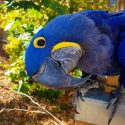
Hyacinth Macaw Natural History
Size
These large macaws reach 1 meter in length, with a 127cm wingspan and a weight of 1.7kg.
Habitat and Distribution
This species is found in areas of forest and grassland in Brazil, Bolivia and Paraguay.
Age
The lifespan of the Hyacinth Macaw is around 50 years.
Diet
They feed mostly on fruits, nectar, some vegetable matter and seeds. However, their main source of food is nuts such as Brazil nuts, palm nuts and macadamia nuts.
Groups and Breeding
Little is known of the Hyacinth Macaw in the wild, it is thought to live in pairs or small groups.
They tend to mate for life. They often nest in tree cavities and during the breeding season, mothers typically lay two eggs which they incubate while the fathers hunt and bring food back to the nest. The incubation period lasts 28-29 days.
Threats
This species is listed as Vulnerable on the IUCN Red List and their population unfortunately continues to decline. The biggest danger they face is damage to their habitat, but they are also trapped for the illegal pet trade.
Interesting Facts
This is the largest species of flying parrot in the world, the flightless parrot, the kakapo is up to twice as heavy. As far back as 1863 it has been noted in wild populations that they use tools to hold nuts in place while opening them.
The Hyacinth Macaws During Your Day Out in Kent
We are home to three Hyacinth Macaws which are housed either side of the Goliath Palm Cockatoos next to the long flight aviary which is home to a variety of parrot species including Cockatoos and Yellow-headed Amazons. They have huge characters and are named Blue, Dee-Dee and Otis.
The more you know…
Want to know more about this animal? Check out our keeper blogs about them here.